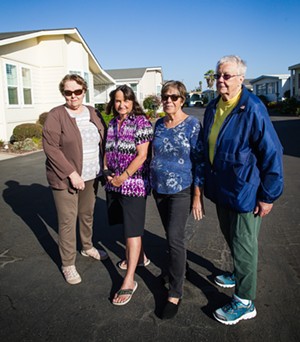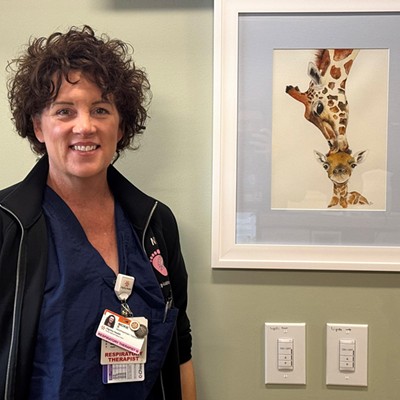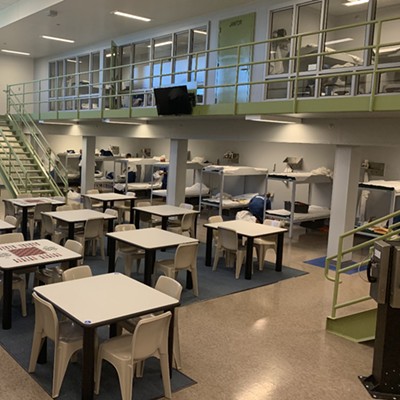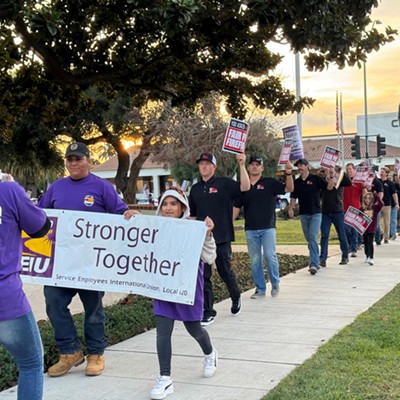Rancho Buena Vista Mobile Home Park resident Gary Hall has spoken at the last 27 Santa Maria City Council meetings. His mission: to get a mobile home rent stabilization ordinance on the council’s agenda.
A rent stabilization ordinance would limit the amount by which landowners can increase the rent each year, said Hall, the North Santa Barbara County Manufactured Homeowners Team president. For the last four years, Hall’s team has been advocating for the ordinance to protect mobile home residents who have to rent the land that their homes sit on.
“I want to be able to maintain affordability for not only me but for all the residents that live in Santa Maria. In Santa Maria, the issue today is that it’s the one that’s been left out,” Hall said.

Neighboring counties and cities including Santa Barbara city, San Luis Obispo (city and county), Buellton, and Santa Ynez all have mobile home rental control ordinances in place, he said. Santa Maria is one of the remaining cities without an ordinance, and it doesn’t look like one will be added anytime soon, Hall said.
“I think that it’s because of politics. We don’t have a City Council yet that is of a mind to listen to their citizens and provide that level of protection that’s been offered at other places. They’ve demonstrated that through their past efforts—or lack thereof,” he said.
Mobile home rent stabilization has been presented to the council since 2018. In 2019, the item finally made the City Council’s agenda in the form of an enforceable model lease—a lease that has a 6 percent ceiling on yearly rent increases that the landowners can choose to offer by signing a contract—according to previous Sun reporting.
But the outcome was not favorable for mobile home residents, Hall said, because the city doesn’t require landowners to use the lease.
Landowners continued business as usual, he said, and it’s ultimately affecting those living in mobile home parks. Hall’s rent increased by 22 percent from $722 a month in 2014 to $937 in 2022. He said he’s still managing well but is worried about others who may not be as financially stable as him.
“Let’s get equity in the hands of mobile homeowners of Santa Maria. I’ve met a lot of mobile homeowners in Santa Maria who—quite frankly—probably have less than I do and need more help,” Hall said.
Other efforts
The city of Santa Barbara adopted its Mobile Home and Recreational Vehicle Park Lease Ordinance in 1984, which limits rent increases to only one time per year with a maximum increase of 3 percent per year, according to the city’s website.
A recent addition to that city’s ordinance is vacancy control—which limits a landowner’s ability to raise the price to market price when a tenant leaves—Santa Barbara City Attorney Ariel Calonne said.
“The economics of mobile home parks are a bit unusual because you have the residents owning their coach but renting the land. … By imposing the high rent on a new owner, that can devalue the coach. A coach paying $300 per month is more in value than a coach paying $1,500 per month in rent,” Calonne explained.
These two pieces working hand in hand protect tenants because they limit extreme rent increases, hold the value of the home, and keep the city involved, he added.
“I do see enforcement,” Calonne said. “There are a number of management companies who are known for fairly abusive landlord-tenant practices, given that mobile home park populations [are] senior citizens and those who are at the lower socioeconomic end of the spectrum. The city has to be involved to ensure they are compliant with the law.”
Not only does this protect mobile home residents, it protects an affordable housing option in the city. Currently, Santa Barbara’s median gross rent is $1,874 per month—according to U.S. census data—and Santa Maria’s rent is not too far behind at $1,475 per month. But Santa Maria’s median household income is about $13,900 less than its neighbor ($81,618 in Santa Barbara and $67,634 in Santa Maria).
And yet, a mobile home rent control ordinance doesn’t exist in Santa Maria even as the city pursues more than 300 other affordable housing projects, Councilmember Gloria Soto said. Soto has advocated for mobile home residents during City Council meetings, and she requested that the ordinance be added to the council discussion agenda during the city’s March 2 meeting.
“For a city that says it’s investing in reducing homelessness, there are things that could be done that aren’t being done,” she told the Sun. “I’m invested because housing costs are just ridiculous at this point, with inflation having gone up as much as it has. Now, more than ever, it’s imperative to protect affordable housing, and mobile homes are a type of affordable housing that houses some of our most vulnerable residents in our community.”
Despite her continued efforts, Soto said her hands are tied because it’s ultimately up to the mayor—Alice Patino—to decide what goes on the agenda, and she can’t speak about the item outside of meetings because of the Brown Act regulations.
“It’s ridiculous, and I also feel like it’s a stubborn council. I really worry; I understand their mind may be set, but it won’t hurt to have a discussion again,” Soto said. “The way in which the city operates is with a really strong mayor and that’s the way the charter’s written. The mayor is the only one who is authorized on what items to agendize, and that’s also really frustrating.”
Mayor Alice Patino could not be reached for comment before the Sun’s deadline.
An unknown future
Councilmember Soto is not the only frustrated one. La Maria Mobile Home Park resident Eileen Armijo has been a part of the ongoing pleas with the City Council because she sees the impact lack of stabalized rent has on her neighbors, she said.
“I looked at some of the people here and saw how hard they were struggling. The inequality of rent raised didn’t seem fair or correct,” Armijo said. “The owner is an LLC—a corporation—and they want profits and a return on their investment.”
Armijo and her husband have been in the park since 2013 and pay about $700 per month, but she said she knew others paying about $1,000 per month because the property owners increase rent prices every time a new tenant joins.
“I feel a little bit of guilt because I’m more comfortable, but I feel for these people, and it’s not right,” she said. “All we’re asking for is fairness. They deserve to make their profits, but not to do this, to have such a one-sided approach.”
She joined Hall’s North Santa Barbara County team to advocate for an ordinance, but said she feels the mobile home residents are ignored by Mayor Patino and Councilmember Etta Waterfield.
“It’s very hard. I go with Gary [Hall] most weeks. I’ve been [in meetings] a couple of times, and Patino and Waterfield are hand in hand. We went one week and they got up and got water while we were talking. I think they just wish we’d go away,” Armijo said. “What I don’t understand is the city wants and needs affordable housing, and yet mobile homes for seniors could be affordable housing but [rents] are going up at atrocious rates.
“How do you justify that as a city that wants affordable housing?”
Reach Staff Writer Taylor O’Connor at [email protected].









